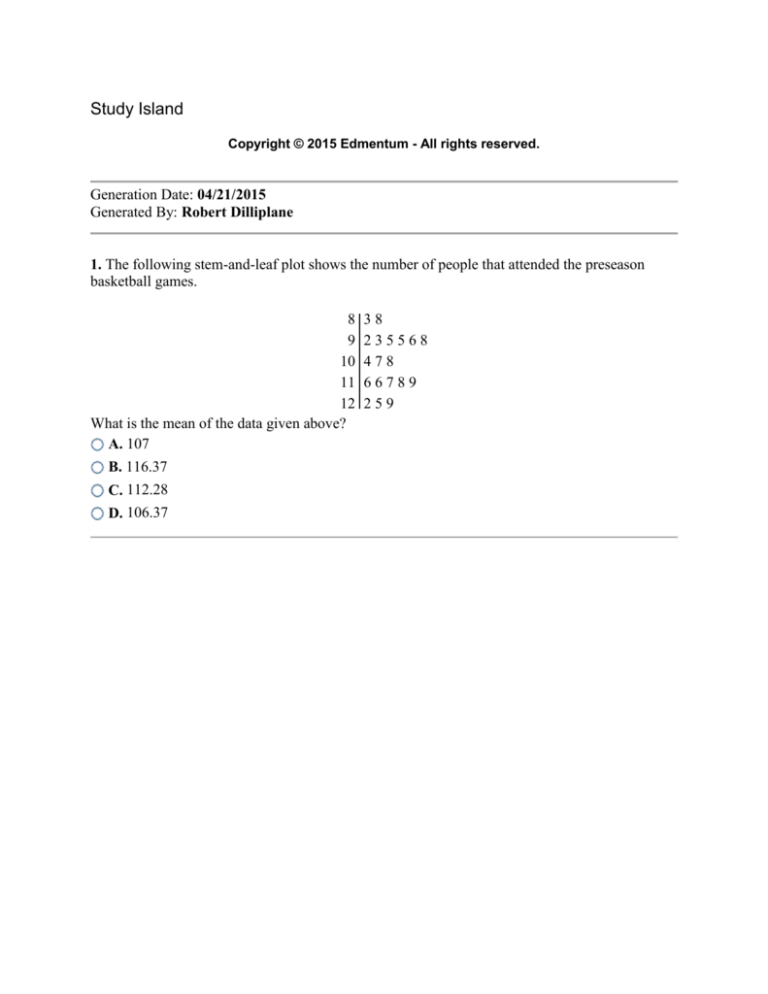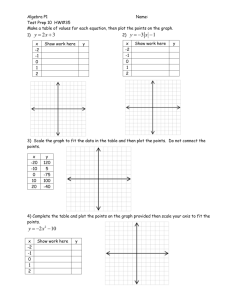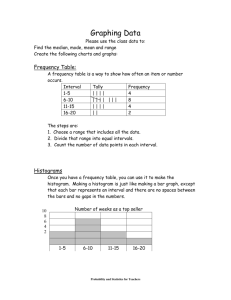
Study Island
Copyright © 2015 Edmentum - All rights reserved.
Generation Date: 04/21/2015
Generated By: Robert Dilliplane
1. The following stem-and-leaf plot shows the number of people that attended the preseason
basketball games.
8
9
10
11
12
What is the mean of the data given above?
A. 107
B. 116.37
C. 112.28
D. 106.37
38
235568
478
66789
259
2.
Annita sat outside the grocery store selling cookbooks. She kept track of how many cookbooks
she sold over a seven day period. She added the number of books sold each day to the previous
day and plotted her results on the line graph shown.
When rounded to the nearest whole number, which of the following is closest to the mean
number of cookbooks Annita sold each day?
A. 5
B. 37
C. 24
D. 7
3. Halle planted mint and basil plants in her herb garden. She measured the height of each herb
plant at the end of each week for six weeks. The results are shown in the line graph below.
What is the difference in the ranges for both herbs during the six weeks shown in the graph?
A. 4 cm
B. 6 cm
C. 2 cm
D. 3 cm
4.
A company made a bar graph showing the amount of sales for each month in thousands of
dollars. Which of the following is closest to the median amount of sales for the four-month
period?
A. $3,125
B. $6,250
C. $5,250
D. $7,000
5. The graph below shows the relationship between a team's salary and their winning percentage
in a professional sports league.
Which of the following is a valid conclusion based on the graph?
A. As a team's salary decreases, its winning percentage increases.
B. As a team's salary increases, its winning percentage increases.
C. As a team's salary increases, its winning percentage decreases.
D. There is no relationship between a team's salary and its winning percentage.
6. The following line plot shows the number of donations received during a charity drive. What
is the mean of the data in the graph?
Each X represents one donation.
A. $37.37
B. $36.50
C. $40.50
D. $25.29
7.
stem leaf
711 3 3 4 5 7 9
712 1 1 1 2 4 5 6 7 8 8 8 9 9
713 1 3 3 3 4 6 8 9 9
714 1 2 2 3 3 3 4 7 8 9
715 1 1 2 4 5 6 8 8
What is the range of the data shown in the stem-and-leaf plot above?
A. 45
B. 5
C. 48
D. 38
8.
33, 40, 42, 33, 34, 38, 16, 24,
64, 64, 67, 68, 72, 25, 31, 52, 58
Which of the box-and-whisker plots below represents the data set above?
A. Y
B. W
C. Z
D. X
W.
X.
Y.
Z.
9. A group of band instructors answered a survey about hours of rehearsal per week and number
of competitions won. The graph shows the results of this survey.
Based on these results, if a band practices 5 hours per week next season, which is the best
estimate of the number of competitions the band can expect to win?
A. 27
B. 36
C. 38
D. 31
10. Mr. Snowdon posted the final exam grades for Algebra II in the hallway as soon as the tests
were graded. The data is represented on the box plot below.
Which set of data below represents the interquartile range and the first quartile, in that order?
A. 22, 67
B. 77, 89
C. 28, 67
D. 44, 64
Answers
1. D
2. A
3. D
4. B
5. B
6. B
7. A
8. B
9. D
10. A
Explanations
1. In a stem-and-leaf plot, the leaf is always the last digit in the number (the ones place), and the
stem is the entire number except the last digit (that is the tens place or the tens place and
hundreds place).
There are 19 numbers in this data set. To find the mean, add all of the numbers together and
divide by 19. Once the answer is determined, round to the nearest hundredths place.
2,021 ÷ 19 = 106.37
2. To find the mean, divide the total number of cookbooks sold by the total number of days
Annita sold cookbooks outside the grocery store.
37 ÷ 7 = 5.2857142857
The answer that is closest to the mean when rounded to the nearest whole number is 5.
So, Annita sold approximately 5 cookbooks each day.
3. To find the range, subtract the original plant height from the height at the end of the sixth
week.
First, find the range for the basil plant.
17 cm - 4 cm = 13 cm
Next, find the range for the mint plant.
11 cm - 1 cm = 10 cm
Last, find the difference in the ranges.
13 cm - 10 cm = 3 cm
4. In May, there were about 5,500 dollars in sales.
In June, there were 8,000 dollars in sales.
In July, there were about 2,500 dollars in sales.
In August, there were 7,000 dollars in sales.
To find the median amount, put the monthly amounts in order from least to greatest.
$2,500, $5,500, $7,000, $8,000
Since there are 4 amounts, the median amount will be the average of the two middle amounts.
Therefore, the median amount is $6,250.
5. The dots on this scatter plot have a pattern. As a team's salary increases, its winning
percentage increases as well. This shows a positive relationship between the two variables.
6. To find the mean, add each value and divide by 20.
Therefore, the mean is $36.50.
7. The lowest number on the stem side is 711; the lowest number on the leaf side for that stem is
3. Thus, the lowest number on the plot is 7,113.
The highest number on the stem side is 715; the highest number on the leaf side for that stem is
8. Thus, the highest number on the plot is 7,158.
The range of the given data set is the difference between the highest value and the lowest value
of the set. Subtract 7,113 from 7,158 to find the range.
8. First, write the numbers in ascending order.
16, 24, 25, 31, 33, 33, 34, 38, 40, 42, 52, 58, 64, 64, 67, 68, 72
Then, find the median of the set of numbers.
16, 24, 25, 31, 33, 33, 34, 38, 40, 42, 52, 58, 64, 64, 67, 68, 72
Next, find the median of the numbers below 40. Since there are 8 numbers, average the middle
values.
16, 24, 25, 31, 33, 33, 34, 38, 40, 42, 52, 58, 64, 64, 67, 68, 72
Next, find the median of the numbers above 40. Since there are 8 numbers, average the middle
values.
16, 24, 25, 31, 33, 33, 34, 38, 40, 42, 52, 58, 64, 64, 67, 68, 72
The extreme values are 16 and 72.
Therefore, box plot W is the correct choice.
9. A best-fit line drawn on the scatter plot (a line that represents that average of the points on the
plot) would cross the 5-hour rehearsal line at approximately 31 competitions won.
10. Quartiles separate a data set into 4 equal parts and each of the parts contains 1/4 of the data.
On the box-and-whisker plot, 67 is the first quartile.
To determine the interquartile range of the data, subtract the first quartile, (67), from the third
quartile (89).
89 - 67 = 22
Therefore, the correct order of the data is 22, 67.







